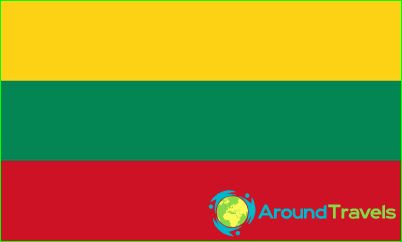Lithuania flag

The national flag of Lithuania is the state symbol of the Republic of Lithuania (Lietuvos Respublika) and is a rectangular panel with an aspect ratio of 3: 5, which consists of three horizontal stripes of equal width: the upper stripe is painted in dark yellow, the middle stripe is in dark green, bottom stripe - red.
The background to the creation of the modern national flag of Lithuania is as follows:
In 1917, the revival of statehood began on the territory of Lithuania. There was a question about the national flag. The proposal to approve the coat of arms, which is now the state historical flag of Lithuania (on both sides, a horseman in armor in the colors of the state coat of arms of Lithuania is depicted on a red cloth), was not supported due to the difficulties of manufacturing this flag. To make the flag truly popular, they decided to take the colors prevailing in traditional Lithuanian fabrics as a basis. This is how the artist Antanas muidzinavičius came up with a two-color green-red flag. But the delegates to the Lithuanian conference, which took place in September 1917 and elected the Council of Lithuania, did not approve of this version of the flag, as the flag seemed pessimistic to them. The newly created commission for the development of the flag proposed to approve the flag of Lithuania Minor (the name of the historical region), which is a horizontal tricolor of equal stripes of green, white and red. But this version of the flag was also rejected as «Protestant». As an alternative, the commission proposed adding a yellow color, considered the color of Catholicism, to the two-color green-red flag. But the narrow yellow stripe in the middle of the two-colored flag, which was supposed to symbolize sunrise, was also not approved. Ultimately, after lengthy discussions, on April 19, 1918, the commission decided that the national flag of Lithuania would be a yellow-green-red tricolor. And on April 25, 1918, the Council of Lithuania unanimously approved this version as the national flag of Lithuania.
In the same form, the flag exists today, the only thing that has changed since then is the aspect ratio of the flag, originally it was 2: 3, and now 3: 5, as well as a shade of red, a very dark shade of red was used before (close to magenta), now a lighter tone is applied.
Officially, the colors of the flag were interpreted as follows: yellow - sun, light, prosperity; green - grass, beauty of nature, freedom and hope; red - earth, courage and blood of heroes, sprinkled on their native land. Ordinary Lithuanians liked the new flag. They identified the yellow color not only with the sun, but also with the color of honey, ripe ears, girl's hair, fresh wood and gold. A peculiar, folk legend has spontaneously developed, which described the flag as follows: a green cereal grows from the red earth and ripens into a yellow ear.
In the Constitutions of 1922 and 1928, the yellow-green-red tricolor was named state. Despite all the attempts of the intelligentsia to change this flag, beloved by the people, it remained unchanged in the Constitution of 1938 and was already correctly recorded as the national flag of Lithuania. On July 30, 1940, the tricolor flag of Lithuania was abolished by a decree of the Minister of the Interior of the Lithuanian SSR. Only with the beginning of perestroika became the official revival of the national tricolor flag of Lithuania possible. On October 7, 1988, at 10 a.m., after many decades of oblivion, the tricolor again hovered over the Gediminas Tower in the Vilnius Upper Castle, this became a symbol of the spiritual liberation of Lithuanians. Since then and until now the yellow-green-red tricolor is the national flag of Lithuania..


